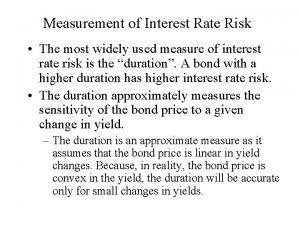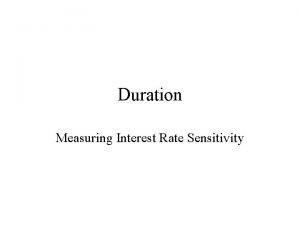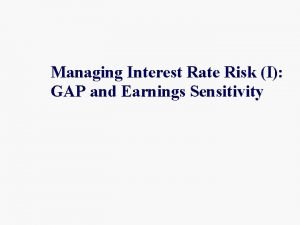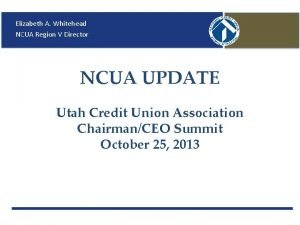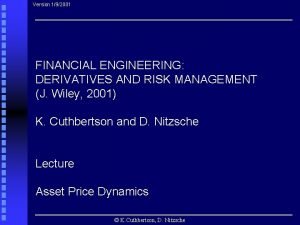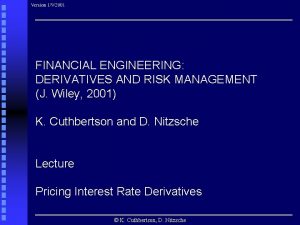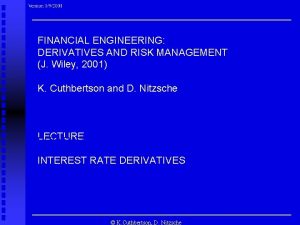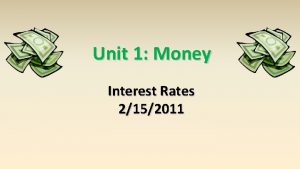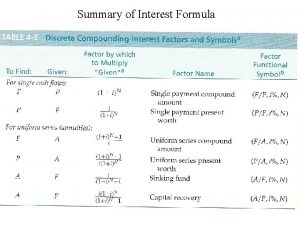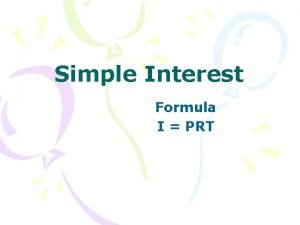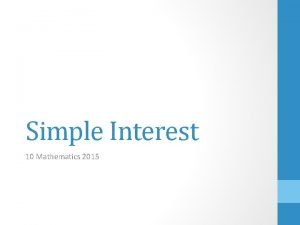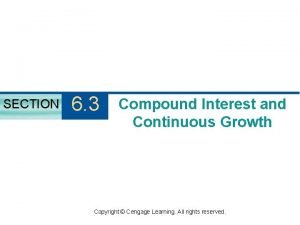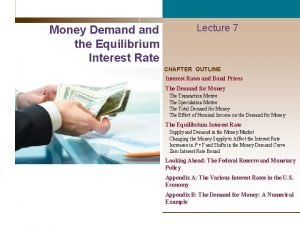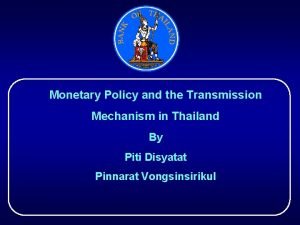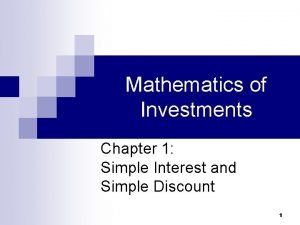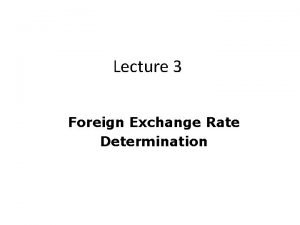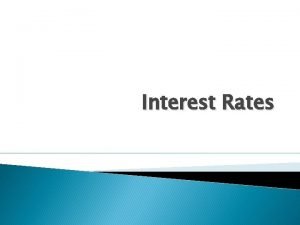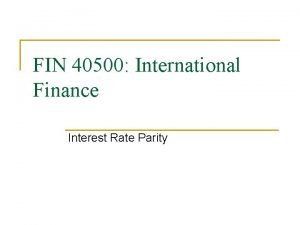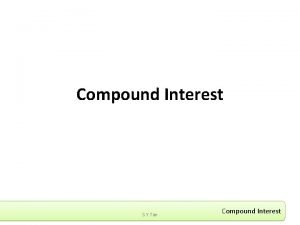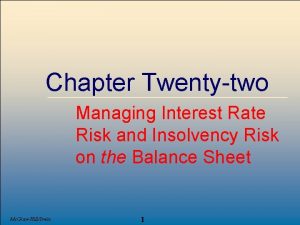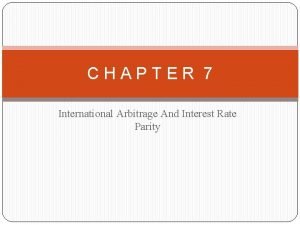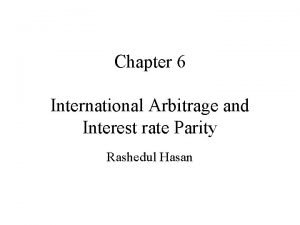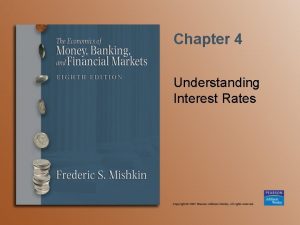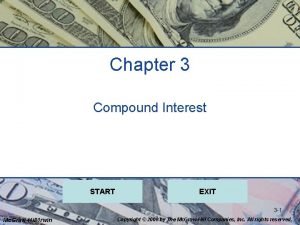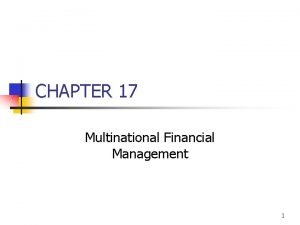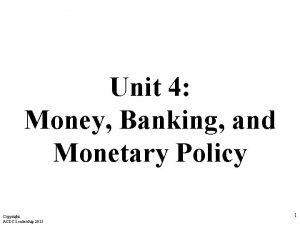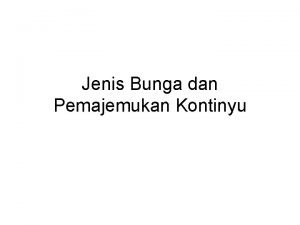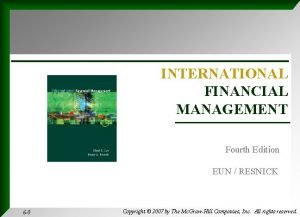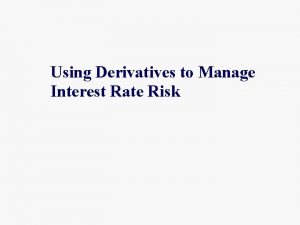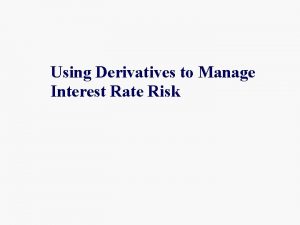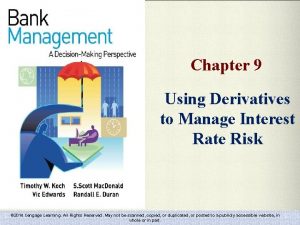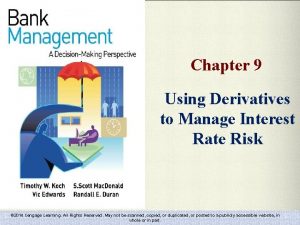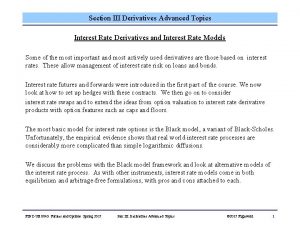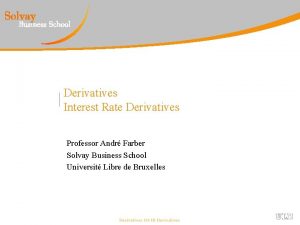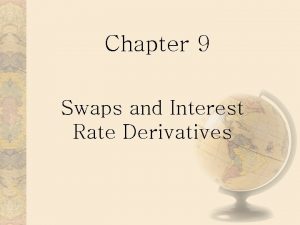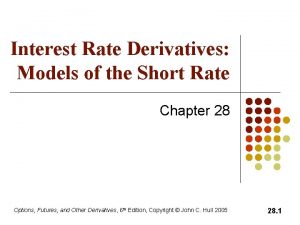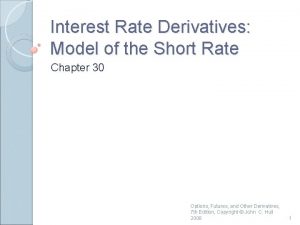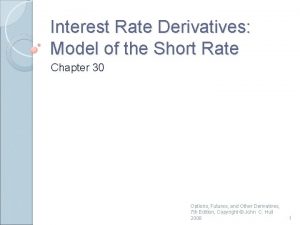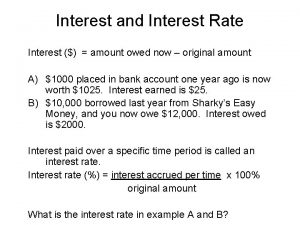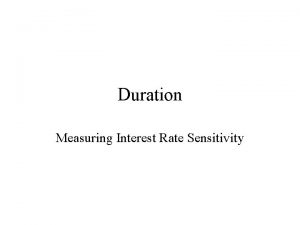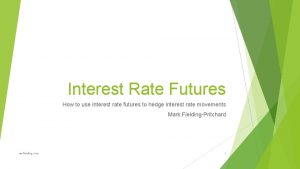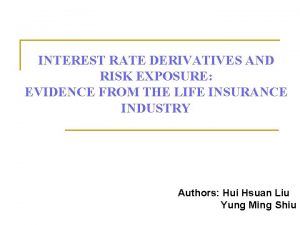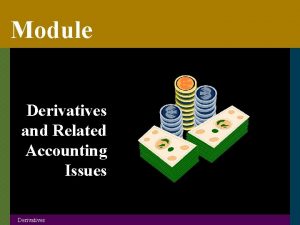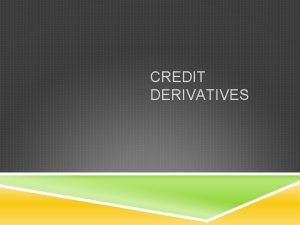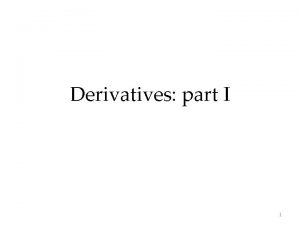Using Derivatives to Manage Interest Rate Risk Derivatives


















































- Slides: 50

Using Derivatives to Manage Interest Rate Risk

Derivatives n A derivative is any instrument or contract that derives its value from another underlying asset, instrument, or contract.

Managing Interest Rate Risk n Derivatives Used to Manage Interest Rate Risk n Financial Futures Contracts n Forward Rate Agreements n Interest Rate Swaps n Options on Interest Rates Interest Rate Caps n Interest Rate Floors n

Characteristics of Financial Futures n Financial Futures Contracts n A commitment, between a buyer and a seller, on the quantity of a standardized financial asset or index n Futures Markets n The organized exchanges where futures contracts are traded n Interest Rate Futures n When the underlying asset is an interest-bearing security n Buyers n A buyer of a futures contract is said to be long futures n Agrees to pay the underlying futures price or take delivery of the underlying asset n Buyers gain when futures prices rise and lose when futures prices fall n Sellers n A seller of a futures contract is said to be short futures n Agrees to receive the underlying futures price or to deliver the underlying asset n Sellers gain when futures prices fall and lose when futures prices rise

Characteristics of Financial Futures n Cash or Spot Market n Market for any asset where the buyer tenders payment and takes possession of the asset when the price is set n Forward Contract n Contract for any asset where the buyer and seller agree on the asset’s price but defer the actual exchange until a specified future date n Forward versus Futures Contracts n Traded on formal exchanges § Examples: Chicago Board of Trade and the Chicago Mercantile Exchange n n Involve standardized instruments Positions require a daily marking to market Positions require a deposit equivalent to a performance bond Forward contracts n n Terms are negotiated between parties Do not necessarily involve standardized assets Require no cash exchange until expiration No marking to market

Margin Requirements n Initial Margin n A cash deposit (or U. S. government securities) with the exchange simply for initiating a transaction n Initial margins are relatively low, often involving less than 5% of the underlying asset’s value n Maintenance Margin n The minimum deposit required at the end of each day n Unlike margin accounts for stocks, futures margin deposits represent a guarantee that a trader will be able to make any mandatory payment obligations n Same effect as a performance bond n Marking-to-Market n The daily settlement process where at the end of every trading day, a trader’s margin account is: n n Credited with any gains Debited with any losses n Variation Margin n The daily change in the value of margin account due to marking-to-market

Expiration and Delivery n Expiration Date n Every futures contract has a formal expiration date n On the expiration date, trading stops and participants settle their final positions n Less than 1% of financial futures contracts experience physical delivery at expiration because most traders offset their futures positions in advance

Example n 90 -Day Eurodollar Time Deposit Futures n The underlying asset is a Eurodollar time deposit with a 3 month maturity. n Eurodollar rates are quoted on an interest-bearing basis, assuming a 360 -day year. n Each Eurodollar futures contract represents $1 million of initial face value of Eurodollar deposits maturing three months after contract expiration. n Forty separate contracts are traded at any point in time, as contracts expire in March, June, September and December each year n Buyers make a profit when futures rates fall (prices rise) n Sellers make a profit when futures rates rise (prices fall) n Contracts trade according to an index that equals n 100% - the futures interest rate § An index of 94. 50 indicates a futures rate of 5. 5 percent n Each basis point change in the futures rate equals a $25 change in value of the contract (0. 0001 x $1 million x 90/360)

Eurodollar Futures n The first column indicates the n n settlement month and year Each row lists price and yield data for a distinct futures contract that expires sequentially every three months The next four columns report the opening price, high and low price, and closing settlement price. The next column, the change in settlement price from the previous day. The two columns under Yield convert the settlement price to a Eurodollar futures rate as: 100 - Settlement Price = Futures Rate

The Basis n The basis is the cash price of an asset minus the corresponding futures price for the same asset at a point in time n For financial futures, the basis can be calculated as the futures rate minus the spot rate n It may be positive or negative, depending on whether futures rates are above or below spot rates n May swing widely in value far in advance of contract expiration

The Relationship Between Futures Rates and Cash Rates - One Possible Pattern on March 10 Rate (Percent) 4. 50 December 2005 Futures Rate 4. 09 Cash Rate 3. 00 1. 76 Basis Futures Rate- Cash Rate 1. 09 0 March 10, 2005 August 23, 2005 Expiratio December 20, 2005

Speculation versus Hedging n A speculator takes on additional risk to earn speculative profits n Speculation is extremely risky n A hedger already has a position in the cash market and uses futures to adjust the risk of being in the cash market n The focus is on reducing or avoiding risk n Example n Speculating n You believe interest rates will fall, so you buy Eurodollar futures § If rates fall, the price of the underlying Eurodollar rises, and thus the futures contract value rises earning you a profit § If rates rise, the price of the Eurodollar futures contract falls in value, resulting in a loss n Hedging n A bank anticipates needing to borrow $1, 000 in 60 days. The bank is concerned that rates will rise in the next 60 days § A possible strategy would be to short Eurodollar futures. § If interest rates rise (fall), the short futures position will increase (decrease) in value. This will (partially) offset the increase (decrease) in borrowing costs

Speculation versus Hedging n With financial futures, risk often cannot be eliminated, only reduced. n Traders normally assume basis risk in that the basis might change adversely between the time the hedge is initiated and closed n Perfect Hedge n The gains (losses) from the futures position perfectly offset the losses (gains) on the spot position at each price

Profit Diagrams for the December 2005 Eurodollar Futures Contract: Mar 10, 2005

Steps in Hedging n Identify the cash market risk exposure to reduce n Given the cash market risk, determine whether a n n n long or short futures position is needed Select the best futures contract Determine the appropriate number of futures contracts to trade. Buy or sell the appropriate futures contracts Determine when to get out of the hedge position, either by reversing the trades, letting contracts expire, or making or taking delivery Verify that futures trading meets regulatory requirements and the banks internal risk policies

A Long Hedge n A long hedge (buy futures) is appropriate for a participant who wants to reduce spot market risk associated with a decline in interest rates n If spot rates decline, futures rates will typically also decline so that the value of the futures position will likely increase. n Any loss in the cash market is at least partially offset by a gain in futures

Long Hedge Example n On March 10, 2005, your bank expects to receive a $1 million payment on November 8, 2005, and anticipates investing the funds in 3 -month Eurodollar time deposits n n The cash market risk exposure is that the bank will not have access to the funds for eight months. In March 2005, the market expected Eurodollar rates to increase sharply as evidenced by rising futures rates. n In order to hedge, the bank should buy futures contracts n The best futures contract will generally be the December 2005, 3 -month Eurodollar futures contract, which is the first to expire after November 2005. n The contract that expires immediately after the known cash transactions date is generally best because its futures price will show the highest correlation with the cash price.

Long Hedge Example n The time line of the bank’s hedging activities would look something like this:

Long Hedge Example Date Cash Market Futures Market Basis 3/10/05 (Initial futures position) 11/8/05 (Close futures position) Net effect Bank anticipates investing $1 million in Eurodollars in 8 months; current cash rate = 3. 00% Bank invests $1 million in 3 -month Eurodollars at 3. 93% Bank buys one December 2005 Eurodollar futures contract at 4. 09%; price = 95. 91 Bank sells one December 2005 Eurodollar futures contract at 4. 03%; price = 95. 97% Futures profit: 4. 09% - 4. 03% = 0. 06%; 6 basis points worth $25 each = $150 4. 09% - 3. 00% = 1. 09% Opportunity gain: 3. 93% - 3. 00% = 0. 93%; 93 basis points worth $25 each = $2, 325 Cumulative e investment income: Interest at 3. 93% = $1, 000(. 0393)(90/360) = $9, 825 Profit from futures trades = $ 150 Total = $9, 975 4. 03% - 3. 93% = 0. 10% Basis change: 0. 10% - 1. 09% = -0. 99%

A Short Hedge n A short hedge (sell futures) is appropriate for a participant who wants to reduce spot market risk associated with an increase in interest rates n If spot rates increase, futures rates will typically also increase so that the value of the futures position will likely decrease. n Any loss in the cash market is at least partially offset by a gain in the futures market n On March 10, 2005, your bank expects to sell a sixmonth $1 million Eurodollar deposit on August 15, 2005 n n The cash market risk exposure is that interest rates may rise and the value of the Eurodollar deposit will fall by August 2005 In order to hedge, the bank should sell futures contracts

Short Hedge Example n The time line of the bank’s hedging activities would look something like this:

Short Hedge Example

Change in the Basis n Long and short hedges work well if the futures rate moves in line with the spot rate n The actual risk assumed by a trader in both hedges is that the basis might change between the time the hedge is initiated and closed n In the long hedge position above, the spot rate increased by 0. 93% while the futures rate fell by 0. 06%. This caused the basis to fall by 0. 99% (The basis fell from 1. 09% to 0. 10%, or by 0. 99%) n Effective Return from a Hedge n Total income from the combined cash and futures positions relative to the investment amount n Effective return n Initial Cash Rate - Change in Basis n In the long hedge example: § 3. 00% - (-0. 99%) = 3. 99%

Basis Risk and Cross Hedging n Cross Hedge n Where a trader uses a futures contract based on one security that differs from the security being hedged in the cash market n Example § Using Eurodollar futures to hedge changes in the commercial paper rate n Basis risk increases with a cross hedge because the futures and spot interest rates may not move closely together

Microhedging Applications n Microhedge n The hedging of a transaction associated with a specific asset, liability or commitment n Macrohedge n Taking futures positions to reduce aggregate portfolio interest rate risk n Banks are generally restricted in their use of financial futures for hedging purposes n Banks must recognize futures on a micro basis by linking each futures transaction with a specific cash instrument or commitment n Many analysts feel that such micro linkages force microhedges that may potentially increase a firm’s total risk because these hedges ignore all other portfolio components

The Mechanics of Applying a Microhedge Determine the bank’s interest rate position Forecast the dollar flows or value expected in cash market transactions 3. Choose the appropriate futures contract 4. Determine the correct number of futures contracts 1. 2. n Where n NF = number of futures contracts n A = Dollar value of cash flow to be hedged n F = Face value of futures contract n Mc = Maturity or duration of anticipated cash asset or liability n Mf = Maturity or duration of futures contract Determine the Appropriate Time Frame for the Hedge 6. Monitor Hedge Performance 5.

Macrohedging n Macrohedging Focuses on reducing interest rate risk associated with a bank’s entire portfolio rather than with individual transactions n Hedging: GAP or Earnings Sensitivity n If GAP is positive (negative), the bank is asset (liability) sensitive and its net interest income rises (falls) when interest rates rise (falls) and falls (rises) when interest rates fall (rise) n Positive GAP: Use a long hedge n Negative GAP: Use a short hedge n Hedging: Duration GAP and EVE Sensitivity n Futures can be used to adjust the bank’s duration gap n The appropriate size of a futures position can be determined by solving the following equation for the market value of futures contracts (MVF), where DF is the duration of the futures contract n

Hedging: Duration GAP and EVE Sensitivity n Example: n A bank has a positive duration gap of 1. 4 years, therefore, the market value of equity will decline if interest rates rise. The bank needs to sell interest rate futures contracts in order to hedge its risk position n n Assume the bank uses a Eurodollar futures contract currently trading at 4. 9% with a duration of 0. 25 years, the target market value of futures contracts (MVF) is: n n The short position indicates that the bank will make a profit if futures rates increase MVF = $4, 024. 36, so the bank should sell four Eurodollar futures contracts If all interest rates increased by 1%, the profit on the four futures contracts would total 4 x 100 x $25 = $10, 000, which partially offset the $12, 000 decrease in the economic value of equity associated with the increase in cash rates n Recall from Exhibit 6. 2, the unhedged bank had a reduction in EVE of $12, 000

Accounting Requirements and Tax Implications n Regulators generally limit a bank’s use of futures for hedging purposes If a bank has a dealer operation, it can use futures as part of its trading activities n In such accounts, gains and losses on these futures must be marked-to-market, thereby affecting current income n Microhedging n n To qualify as a hedge, a bank must show that a cash transaction exposes it to interest rate risk, a futures contract must lower the bank’s risk exposure, and the bank must designate the contract as a hedge

Using Forward Rate Agreements to Manage Interest Rate Risk n Forward Rate Agreements n A forward contract based on interest rates based on a notional principal amount at a specified future date n Buyer n Agrees to pay a fixed-rate coupon payment (at the exercise rate) and receive a floating-rate payment n Seller n Agrees to make a floating-rate payment and receive a fixed-rate payment n The buyer and seller will receive or pay cash when the actual interest rate at settlement is different than the exercise rate

Forward Rate Agreements (FRA) n Similar to futures but differ in that they: n Are negotiated between parties n Do not necessarily involve standardized assets n Require no cash exchange until expiration n There is no marking-to-market n No exchange guarantees performance

Notional Principal n The two counterparties to a forward rate agreement agree to a notional principal amount that serves as a reference figure in determining cash flows. n Notional n Refers to the condition that the principal does not change hands, but is only used to calculate the value of interest payments. n Buyer n Agrees to pay a fixed-rate coupon payment and receive a floating-rate payment against the notional principal at some specified future date. n Seller n Agrees to pay a floating-rate payment and receive the fixed -rate payment against the same notional principal.

Example: Forward Rate Agreements n Suppose that Metro Bank (as the seller) enters into a receive n n n fixed-rate/pay floating-rating forward rate agreement with County Bank (as the buyer) with a six-month maturity based on a $1 million notional principal amount The floating rate is the 3 -month LIBOR and the fixed (exercise) rate is 7% Metro Bank would refer to this as a “ 3 vs. 6” FRA at 7 percent on a $1 million notional amount from County Bank The phrase “ 3 vs. 6” refers to a 3 -month interest rate observed three months from the present, for a security with a maturity date six months from the present The only cash flow will be determined in six months at contract maturity by comparing the prevailing 3 -month LIBOR with 7% Assume that in three months 3 -month LIBOR equals 8% n In this case, Metro Bank would receive from County Bank $2, 451. n The interest settlement amount is $2, 500: § Interest = (. 08 -. 07)(90/360) $1, 000 = $2, 500. n Because this represents interest that would be paid three months later at maturity of the instrument, the actual payment is discounted at the prevailing 3 -month LIBOR: § Actual interest = $2, 500/[1+(90/360). 08]=$2, 451

Example: Forward Rate Agreements n If instead, LIBOR equals 5% in three months, Metro Bank would pay County Bank: n The interest settlement amount is $5, 000 n n Interest = (. 07 -. 05)(90/360) $1, 000 = $5, 000 Actual interest = $5, 000 /[1 + (90/360). 05] = $4, 938 n The FRA position is similar to a futures position n County Bank would pay fixed-rate/receive floating-rate as a hedge if it was exposed to loss in a rising rate environment. n This is analogous to a short futures position

Basic Interest Rate Swaps n Basic or Plain Vanilla Interest Rate Swap n An agreement between two parties to exchange a series of cash flows based on a specified notional principal amount n Two parties facing different types of interest rate risk can exchange interest payments n One party makes payments based on a fixed interest rate and receives floating rate payments n The other party exchanges floating rate payments for fixedrate payments n When interest rates change, the party that benefits from a swap receives a net cash payment while the party that loses makes a net cash payment n Conceptually, a basic interest rate swap is a package of FRAs n As with FRAs, swap payments are netted and the notional principal never changes hands

Basic Interest Rate Swaps n Using data for a 2 -year swap based on 3 -month LIBOR as the floating rate n This swap involves eight quarterly payments. Party FIX agrees to pay a fixed rate n Party FLT agrees to receive a fixed rate with cash flows calculated against a $10 million notional principal amount n

Basic Interest Rate Swaps

Basic Interest Rate Swaps n Firms with a negative GAP can reduce risk by making a fixed-rate interest payment in exchange for a floating-rate interest receipt n Firms with a positive GAP take the opposite position, by making floating-interest payments in exchange for a fixed-rate receipt n Basic interest rate swaps are used to: n Adjust the rate sensitivity of an asset or liability n n Create a synthetic security n n For example, effectively converting a fixed-rate loan into a floating-rate loan For example, enter into a swap instead of investing in a security Macrohedge n Use swaps to hedge the bank’s aggregate interest rate risk

Basic Swap to Hedge Aggregate Balance Sheet Risk of Loss from Falling Rates Floating Rate Loans Bank Swap Terms: Pay LIBOR, Receive 4. 18 Percent Prime + 1% Three-Month LIBOR Swap Counterparty Bank 4. 18% Fixed 3. 75% Deposits Current Rates Constant Rates Fall 100 Basis Points Rates Rise 100 Basis Points PRIME 5. 50% LIBOR 3. 00% PRIME 4. 50% LIBOR 2. 00% PRIME 6. 50% LIBOR 4. 00% Loan 6. 50% 5. 50% 7. 50% Deposit (3. 75%) Spread 2. 75% 1. 75% 3. 75% Fixed 4. 18% Floating (3. 00%) (2. 00%) (4. 00%) Spread 1. 18% 2. 18% 0. 18% Margin 3. 93% Balance Sheet Flows: Interest Rate Swap Flows:

Using a Basic Swap to Hedge Aggregate Balance Sheet Risk of Loss From Rising Rates Fixed Rate Loans Strategy: Pay 4. 19 Percent, Receive 3 -Month LIBOR Fixed 7. 00% 4. 19% Fixed Swap Counterparty Bank Three-Month LIBOR 3 -Month LIBOR -0. 25% Deposits Current Rates Constant LIBOR 3. 00% Rates Fall Rates Rise 100 Basis Points LIBOR 2. 00% LIBOR 4. 00% Balance Sheet Flows: 7. 00% Deposit (2. 75%) (1. 75%) (3. 75%) Spread 4. 25% 5. 25% 3. 25% (4. 19%) Floating 3. 00% 2. 00% 4. 00% Spread (1. 19%) (2. 19%) (0. 19%) Margin 3. 06% Loan Interest Rate Swap Flows: Fixed

Basic Interest Rate Swaps n Swap Dealers n Handle most swap transactions n Make a market in swap contracts n Offer terms for both fixed-rate and floating rate payers and earn a spread for their services

Basic Interest Rate Swaps n Comparing Financial Futures, FRAs, and Basic Swaps n There is some credit risk with swaps in that the counterparty may default on the exchange of the interest payments n Only the interest payment exchange is at risk, not the principal

Interest Rate Caps and Floors n Interest Rate Cap n An agreement between two counterparties that limits the buyer’s interest rate exposure to a maximum limit n Buying a interest rate cap is the same as purchasing a call option on an interest rate

Buying a Cap on 3 -Month LIBOR at 4 percent

Interest Rate Caps and Floors n Interest Rate Floor n An agreement between two counterparties that limits the buyer’s interest rate exposure to a minimum rate n Buying an interest rate floor is the same as purchasing a put option on an interest rate

Buying a Floor on 3 -Month LIBOR at 4 percent

Pricing Interest Rate Caps and Floors n The size of the premiums for caps and floors is determined by: n The relationship between the strike rate an the current index n This indicates how much the index must move before the cap or floor is inthe-money n The shape of yield curve and the volatility of interest rates n With an upward sloping yield curve, caps will be more expensive than floors

Pricing Interest Rate Caps and Floors

Buy a Cap on 3 -Month LIBOR to Hedge Balance Sheet Rate Risk of Loss from Rising Rates Fixed Rate Loans Strategy: Buy a Cap on 3 -Month LIBOR at 4. 00 Percent Fixed 7. 00% Receive when Bank Three-Month LIBOR > 4. 00% Counterparty Fee: (0. 50%) per year Three-Month LIBOR -0. 25% Deposits Current Rates Constant Rates Fall 100 Basis Points Rates Rise 100 Basis Points LIBOR 3. 00% LIBOR 2. 00% LIBOR 4. 00% Balance Sheet Flows: Loan 7. 00% Deposit (2. 75%) (1. 75%) (3. 75%) Spread 4. 25% 5. 25% 3. 25% Payout 0. 00% 0. 50% Fee Amort. (0. 50%) Spread (0. 50%) 0. 00% Margin 3. 75% 4. 75% 3. 25% Cap Flows:

Buying a Floor on 3 -Month LIBOR to Hedge Aggregate Balance Sheet Risk of Loss From Falling Rates Floating Rate Loans Floor Terms: Buy a 2. 50 Percent Floor on 3 -Month LIBOR Prime + 1% Bank Receive when Three-Month LIBOR < 2. 50% Counterparty Fee: (0. 30%) per year Fixed 3. 75% Deposits Current Rates Constant Rates Fall 100 Basis Points Rates Rise 100 Basis Points PRIME 5. 50% LIBOR 3. 00% PRIME 4. 50% LIBOR 2. 00% PRIME 6. 50% LIBOR 4. 00% Loan 6. 50% 5. 50% 7. 50% Deposit (3. 75%) Spread 2. 75% 1. 75% 3. 75% Payout 0. 00% 0. 50% 0. 00% Fee Amort. (0. 30%) Spread (0. 30%) 0. 20% (0. 30%) Margin 2. 45% 1. 95% 3. 45% Balance Sheet Flows: Floor Flows:
 What is real interest rate and nominal interest rate
What is real interest rate and nominal interest rate Cap rate interest rate relationship
Cap rate interest rate relationship Measure interest rate risk
Measure interest rate risk Hedging interest rate risk with futures
Hedging interest rate risk with futures Interest rate risk sensitivity analysis
Interest rate risk sensitivity analysis Sensitivity analysis interest rate risk
Sensitivity analysis interest rate risk Repricing gap
Repricing gap Ncua aires questionnaire
Ncua aires questionnaire Your uncle would like to restrict his interest rate risk
Your uncle would like to restrict his interest rate risk Risk projection attempts to rate each risk in two ways
Risk projection attempts to rate each risk in two ways Liquidity measures
Liquidity measures Bsbpmg508a
Bsbpmg508a Nominal rate
Nominal rate Simple interest and compound interest
Simple interest and compound interest Financial engineering derivatives and risk management
Financial engineering derivatives and risk management Financial engineering derivatives and risk management
Financial engineering derivatives and risk management Financial engineering derivatives and risk management
Financial engineering derivatives and risk management Interest rate effect
Interest rate effect Discrete interest formula
Discrete interest formula I = p r t
I = p r t What is the simple interest
What is the simple interest Compounded continuously formula
Compounded continuously formula Nominal interest rate equation
Nominal interest rate equation Fisher's equation
Fisher's equation Nominal vs effective interest rate
Nominal vs effective interest rate Money demand and interest rate
Money demand and interest rate Interest rate transmission mechanism
Interest rate transmission mechanism Unit 5 macroeconomics lesson 2 activity 45
Unit 5 macroeconomics lesson 2 activity 45 Ordinary and exact interest formula
Ordinary and exact interest formula Ppp theory of exchange rate
Ppp theory of exchange rate Interest rate quotes
Interest rate quotes Interest rate futures
Interest rate futures Interest rate parity theory formula
Interest rate parity theory formula Uncovered interest rate parity formula
Uncovered interest rate parity formula Interest rate compounded annually
Interest rate compounded annually Interest rate parity example
Interest rate parity example Interest rate duration
Interest rate duration Rate parity rule
Rate parity rule Add-on yield
Add-on yield International arbitrage and interest rate parity
International arbitrage and interest rate parity Mora interest rate
Mora interest rate Interest rate compounded annually
Interest rate compounded annually Intermediate accounting leases
Intermediate accounting leases Interest rate parity example
Interest rate parity example Money includes
Money includes Effective monthly interest rate
Effective monthly interest rate Money supply and interest rate
Money supply and interest rate Is interest rate discrete or continuous
Is interest rate discrete or continuous Agdao multi purpose cooperative
Agdao multi purpose cooperative Interest rate parity
Interest rate parity Forward interest rate formula
Forward interest rate formula


